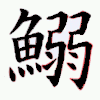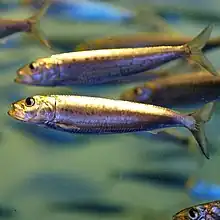鰯
| ||||||||
Translingual
| Stroke order | |||
|---|---|---|---|
 | |||
Han character
鰯 (Kangxi radical 195, 魚+10, 21 strokes, cangjie input 弓火弓一一 (NFNMM), composition ⿰魚弱)
References
- KangXi: not present, would follow page 1476, character 25
- Dai Kanwa Jiten: character 46413
- Hanyu Da Zidian (first edition): volume 7, page 4708, character 9
- Unihan data for U+9C2F
Chinese
| trad. | 鰯 | |
|---|---|---|
| simp. | 𱈍 | |
Glyph origin
魚 (“fish”) + 弱 – sardine, A Japanese kokuji coined phono-semanically (弱し yowashi) in the Nara period.
Pronunciation
References
Korean
Hanja
鰯 • (yak) (hangeul 약, revised yak, McCune–Reischauer yak, Yale yak)
- This term needs a translation to English. Please help out and add a translation, then remove the text
{{rfdef}}.
This article is issued from Wiktionary. The text is licensed under Creative Commons - Attribution - Sharealike. Additional terms may apply for the media files.
